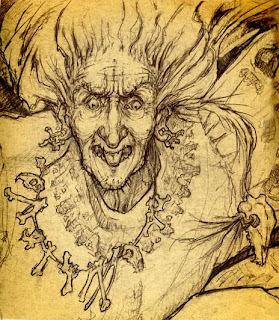This mythological figure was suggested by Rhyll, a member of RWAus’ paranormal group. I had no idea who Baba Yaga was. But now I know some from research online. I would have loved to check out books on this topic, but I didn’t have the time.
 Baba Yaga is a figure in East European mythology, including Slavic and Russian cultures.
Baba Yaga is a figure in East European mythology, including Slavic and Russian cultures. The name of Baba Yaga is composed of two elements. Baba means "grandmother" or "old woman" in most Slavic languages. Yaga is probably a diminutive of the feminine name Jadwiga, in turn, is a Slavicized form of the Germanic Hedwig. Another version is saying the name of Baba Yaga comes from the old Russian verb yagat which means to abuse, to find fault.* Her spelling has different variation depending on which region.

She is cannibalistic witch who lives in a hut (usually with no doors or windows) which has long overgrown chicken legs. The hut will only lower at her command. Surrounding the hut is a fence which has skulls of her victims (nice, right?). In one version, she has a ginger bread house (sound familiar?).
Apparently there were nomadic tribes who used a similar design of cabin for various reasons.
 |
| Sami hut |
 |
| Horsemen portrayed as actual horses. |
Baba Yaga is portrayed as a little, woman with a huge nose and long teeth. she flies on a mortar using the pestle as a rudder. She sweeps sweeping away the tracks behind her with a broom made of silver birch, and a host of spirits follows her. She also has three horsemen as servants, The White Horseman, the Red Horseman, and the Black Horseman (though in another version, it is the same horseman who changes colour during the day).
 |
| This artwork doesn't depict her as ugly. |
In some versions, she was said to have been a good fairy but then was degraded to a witch. I wonder whether this is a reflection of old religions dying and being replaced by Christianity and hence, her being seen as evil because she was a pagan figure. indeed she has appeared in tales as the strange yet wise figure providing advice to the hero on their quest. Seeking out her aid is usually portrayed as a dangerous act. An emphasis is placed on the need for being prepared, of pure spirit, and be polite. A hard bargainer she will eat those who don’t fulfil their agreements (ouch!)
| From film Bartrok the Magnificent |
She may have been another version of the Corn Mother, and therefore a figure of fertility. In this version, the moon’s cycle indicated when to approach her. At the full moon, her door was open, as the witch was sated, happy and pregnant. When the moon wanes, her womb and belly are empty. So danger to anyone who approached because they could become her next meal. So maybe this second part of the myth, is where the “eater of children” comes from.
Baba Yaga is used as a stock character by authors of modern Russian fairy tales, and from the 1990s in Russian fantasy. She is also a favorite subject of Russian films and cartoons. The animated film Bartok the Magnificent features Baba Yaga as a main character but not as an antagonist.
Baba Yaga is not good, but is not entirely evil. She is “the Arch-Crone, the Goddess of Wisdom and Death, the Bone Mother. Wild and untamable, she is a nature spirit bringing wisdom and death of ego, and through death, rebirth.” #
A very fascinating character indeed. So there you have it, Baba Yaga.
# http://www.oldrussia.net/baba.html
http://en.wikipedia.org/wiki/Baba_Yaga
* http://russiapedia.rt.com/of-russian-origin/baba-yaga/
http://en.wikipedia.org/wiki/Baba_Yaga
* http://russiapedia.rt.com/of-russian-origin/baba-yaga/






If you're interested in Baba Jaga, there is an awesome book called "Baba Jaga laid an egg" by Dubravka Ugresic - well worth the investment if you're interested in Eastern European mythology. Great post Eleni
ReplyDeleteThanks Nicola. She can be a great inspiration for many a tale as her history shows.
ReplyDeleteFascinating. I love how Terry Pratchett used Baba Yaga and Voodoo together in "Witches Abroad". So many possibilities.
ReplyDeleteBut that Sami house -- Eleni, it's an amazing photo. Thank you heaps for finding it. I'd never thought about tree stumps being the "chicken legs".
Eleni, great post. I recommend WOMEN WHO RUN WITH THE WOLVES by Clarissa Pinkola Estes for some great insight into the Baba Yaga mythology, as well.
ReplyDeleteI second Michelle's rec. I only read Women Who Run with Wolves this year (thanks to a rec from Taryn Kincaid). I loved the discussion on the power of stories and the "wild woman" in us all.
ReplyDeleteGreat stuff ladies. I may have been clueless about Baba Yaga, but you all aren't. Thanks for the recommendations.
ReplyDeleteAs for the Sami house, I found that fascinating too, Jenny.
Hi Eleni, I'm honored that you used my illustration of Baba Yaga (the sepia face at the top of the post). If you'd like to see more of my images of her, here is a link to some of them:
ReplyDeletehttp://forestrogers.squarespace.com/galleries/illustrated-tales/2377114#
I have also portrayed her in 3-D, art doll style:
http://forestrogers.squarespace.com/home-journal/category/baba-yaga
My best to you,
Forest Rogers
That is so cool that you popped in, Forest and your artwork is amazing.
Delete